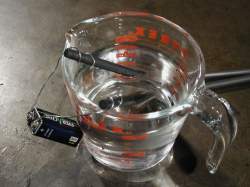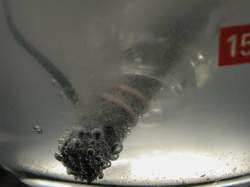Homemade hydrogen
I had a Martha Stewart moment: I made hydrogen from scratch with two batteries, two paper clips, and a cup of salt water.
Making hydrogen gas is actually very easy. I first did it when I was probably 15, and it's really hard to fail. Connect two wires to a 9V battery (cut the connector off an old toy or something, buy one at Radio Shack, or you can just bend paper clips around the terminals like I did), then stick the bare ends of the wire into a bowl of water and you'll get bubbles of gas coming off both wires. One is oxygen, the other is hydrogen.
One improvement is to connect the wires to graphite electrodes, which give you many more bubbles. Get a 6V lantern battery (non-alkaline) and tear it apart. Inside you'll find several bars of graphite that make perfect electrodes for this purpose. Clean them with sandpaper to get rid of all the gunk before using them. (You can see illustrated instructions for this extraction under carbon.)
Here's a picture of the setup I made this sample with, using two of the electrodes from that extraction:

Here is a video of the bubbles forming. The one on the left is making hydrogen: One way to tell is that there is clearly more gas coming off it than off the one on the right. Hydrogen gas is H2 and oxygen is O2. Water is H2O. It's got two atoms of hydrogen for every atom of oxygen, so it stands to reason that you'll get twice as much hydrogen gas.
Putting a tablespoon of salt in the water greatly increases the conductivity, and hence the rate at which gas is formed. Connecting two or more 9V batteries in series also speeds up the process. (You can connect any number of them back-to-back: They just snap together facing each other. Use a separate connector at each end of the chain, or cut one connector in half to separate the two terminals. You can build up to some pretty high voltages with just a handful of batteries, so be careful. In fact, with your hands wet with salt water even a single 9V battery can give you a surprisingly nasty shock. With several in series you should wear rubber gloves, in my opinion.)
Figuring out which gas is which is easy enough: Hold a match near the surface of the water and the bubbles that burn are hydrogen. This is quite safe: They won't explode violently, just burn with little puffs of flame. You may not even see the flame, but you'll hear a crackle. (But see below for some ways in which it can become dangerous.)
If you add salt, you'll also get a simply wonderful smell of chlorine gas, a lot like a swimming pool administered by an overly enthusiastic sanitarian. This means your oxygen gas is not pure, because the chlorine comes off the same terminal as the oxygen. But the hydrogen is pure, because any sodium you electrolyze out will immediately react with the surrounding water, forming more hydrogen and dissolved sodium hydroxide. In other words, the solution will become progressively more basic.
Notice how I'm not telling you whether it's the + or - electrode that makes hydrogen. If you know a little chemistry you can easily figure it out, but I urge you not to. Do the experiment first, determine it by the flame test. Pretend you don't know which is the positive ion: The first people who did this didn't know either.
Here's a picture of the bubbles you'll see with one 9V battery and about a tablespoon of salt in two cups of water:

Once you've got a setup that is making a good quantity of bubbles reliably, you can start collecting the gasses by inverting a bottle or test tube of some sort over one of the electrodes (hint: it's more fun to collect the hydrogen). Start with the bottle completely full of water so your gas won't be mixed with air that was already in the bottle (this is an important safety point as we'll see below).
This video shows the sample being collected, with the capture bottle over the hydrogen electrode. The closer the electrodes, the faster the bubbles flow. Alkaline batteries give you more bubbles: You're actually putting a pretty heavy load on the battery, and it will run dead in maybe 10-15 minutes. It took about 5 minutes to fill my bottle completely full of hydrogen.
If you separate the electrodes and collect each gas separately, you can burn the hydrogen fairly safely just by holding a lit match to the bottle as you uncover the opening. It can't burn too fast, because it has to mix with the oxygen in air before anything happens, and because air is only about 21% oxygen, the rest being non-flammable nitrogen. I would only do this with a small test-tube, never with a narrow-mouthed bottle. You don't want to give it any opportunity to build up pressure inside the bottle. (Yes, I collected this sample in a narrow-mouthed bottle, but I never intended to burn it.)
It's a completely different story if you collect both gasses in the same container. Such a bottle will contain a perfect stoichiometric mixture of pure hydrogen and oxygen: That is a highly explosive mixture because it contains exactly the right proportions needed to burn instantaneously when ignited. If you held a match up to such a bottle, you would get a loud bang and quite likely flying shards of glass. I haven't done it, and I don't think you should either: There are much better ways of making bangs if you want one.
Reader Tim Baverstock suggests another way of collecting the gas: Add a drop of dish washing detergent to the water and then you end up with the gases caught in soap bubbles - just right for holding a match to. Loudest thing I ever heard in a classroom. Presumably in his classroom, the electrodes were set up so that both gasses collected into the same bubbles. If you separate them far enough so that the gasses collect in separate bubbles, you'd get one set of bubbles that burn gently and one set that don't burn at all.
I've seen this demonstration done with soap bubbles being filled from compressed gas cylinders, starting with pure hydrogen and then slowly increasing the amount of oxygen mixed in. There was a steady progression from puffs of flame to loud BANGs that shook the chalk off the chalkboards, no doubt causing a sort of white lung disease in the teacher (in my case, Prof. Zumdahl of the University of Illinois).
But don't let me scare you off this experiment: As long as you don't combine the two gasses in a closed or semi-closed container, it's a quite safe experiment, and great fun. It's certainly by far the safest electrolysis you can do, and it's probably the single easiest way to isolate pure elements (two at once!) from an "ore".
This is also the only simple experiment you can do in which, in a very real sense, you create the atoms you're collecting, rather than just separating and purifying them. Think about what a hydrogen atom is: It's nothing more than a single proton, captured in a cloud of negative charge from the electrons surrounding whatever compound it's part of. When you use electricity to split water, you send an electron from the battery down into the water, where it finds a water molecule, rips off a proton, and the proton and electron combine to form a hydrogen atom. (Technically, two electrons rip off two protons and form a molecule containing two hydrogen atoms, but that's a detail.) The point is that by adding electrons to water, you are creating hydrogen atoms out of two subatomic particles. In virtually every other chemical reaction the atoms already have lots of electrons around them, and you're just making changes around the edges. But here you're making the atoms up pretty much from scratch, no accelerator or nuclear reactor required, just a 9V battery.
I recently saw a really sexy device in a chemical catalog. It's a oxy-hydrogen blow torch that runs on just electricity and water: You don't need any gas cylinders to get just about the hottest flame you can get with chemicals. Of course it works by using the electricity to split the water into hydrogen and oxygen, then piping the gas into the torch nozzle where it combines right back into water, releasing the electrical energy you put in as heat. It sounds trivial, but I'm sure there are a lot of tricks they had to use to get it to work, in the same way that a plasma-arc cutting torch sounds easy, but ends up requiring hafnium of all things in the electrode if you want it to actually cut steel.
And finally, a note about the google ads that appear on this page. These ads are placed automatically by google based on the keywords that occur in this story, and I have no control over which ads show up when. Quite often you will see ones that lead to companies selling devices designed to improve your gas mileage by somehow injecting hydrogen into the gas stream. I think it's pretty safe to say that these devices do not work. You can't get out more energy than you put in, period. Other ads lead to hydrogen generators designed to create and collect hydrogen for various purposes. These are perfectly legitimate, as long as you realize that there is no free lunch: You'll use more energy creating the hydrogen from "free" water than you will be able to recover by burning the hydrogen. So they are great as a way of creating hydrogen, lousy as a way of saving energy.
Anyway, read their claims and judge for yourself, but I want to be clear that I'm not endorsing any product just because their ad happens to show up on my web page.
|
|